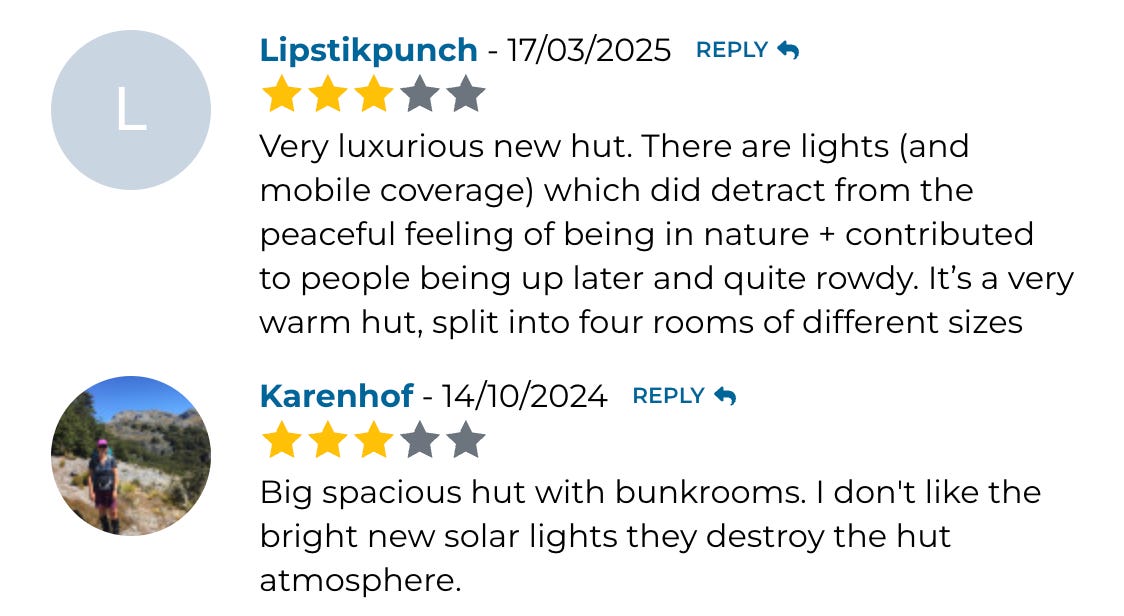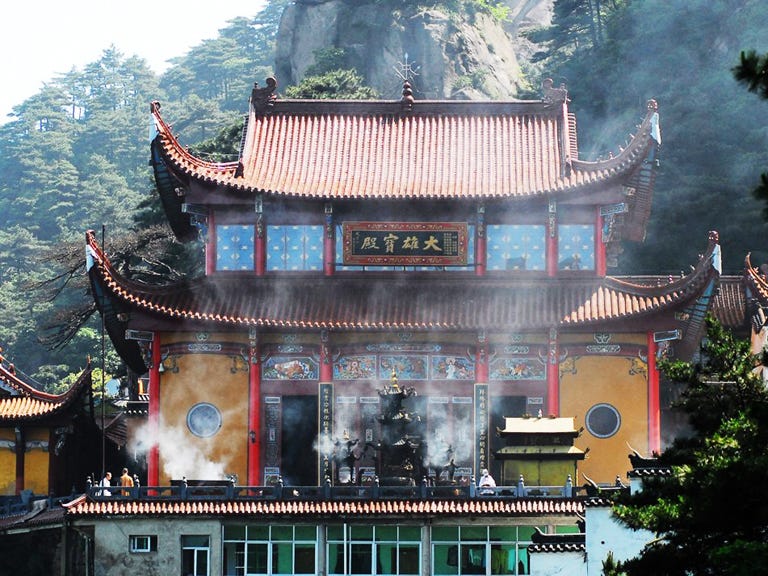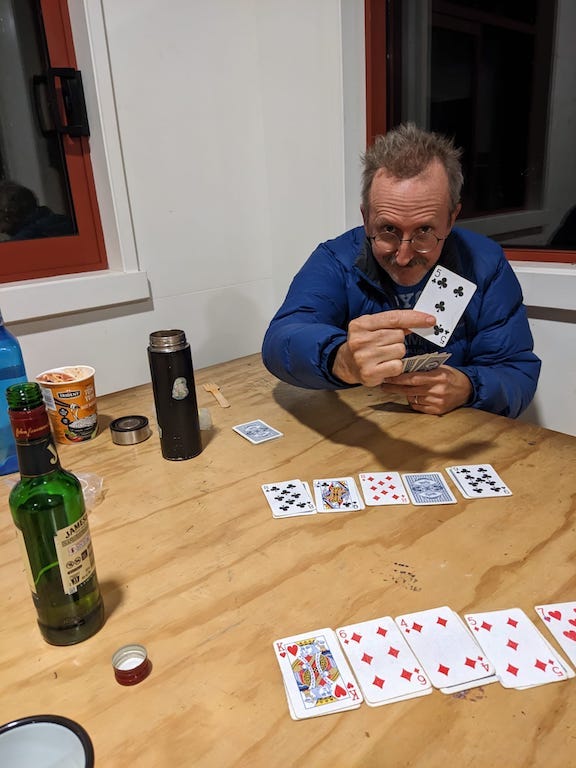Lights In a Hut Are Swimsuits In a Sauna
We go to church to eat our noodles in the dark
I’m excited to report this letter was reprinted in The Spinoff in June 2025. For a day or two it was the Spinoff’s most-read article, and drew a lively bunch of comments arguing for and against lights in huts. Check it out here.
Years ago—the early aughts, must’ve been—I was drinking with an old buddy in a Brooklyn bar you could fairly call hipster. A Tuesday, maybe. Nothing crazy. We just sat and listened to poets or singers or earnest dudes poking at laptops, I don’t remember which. Everyone seemed to know each other. Friends watched friends make art. I remember feeling restless, a step outside the crowd, but then I always felt that way in New York. Was my jacket cool enough? Shouldn’t I be making art, too? My buddy, though, was purring like a cat. This, he said, is my church.
I thought of him last weekend when a Kiwi mate and I stomped into Powell Hut, high on the windswept shoulder of Mt. Holdsworth in the Tararua Forest Park. Powell Hut is a 32-bed jewel—maybe the crown jewel—of New Zealand’s backcountry hut system, which counts nearly a thousand overnight shelters tucked along Department of Conservation (DOC) trails all up and down these islands. (Browse them here.) We had wheezed to the ridgeline deep inside a classic Long White Cloud, and now shed our wet boots in the cloak room, chose our bunks, and joined the trampers already gathered around a cheerful fire. Wet clothes hung on a rack over the stove. The hut’s old dented kettle was still hot. We poured some tea and made gradually deepening smalltalk about the state of the weather, the nation, and the world, then set to sorting the hut’s ancient mismatched decks for a game of cards. This is my church.
Then someone got up and turned on the lights.
What? Huts don’t have electricity! The whole point of a hut is to spend your aprés-tramp unwinding in the gathering 19th-century dusk, letting patient shadows claim the room until the head torches come out. Powell still has the tin wall sconces you see in many DOC huts, which are both pretty fire safe and warmly reflect the candlelight around the room. Last time I was up, previous trampers had left a few candles stuck in old liquor bottles on the table. When was the last time you ate dinner only by candlelight?

I hadn’t been up to Powell since 2020. Did I miss the lights last time? The liquor bottles are gone. There are solar panels out back and a battery for the many, many cloudy days up there. By the front door there’s one of those timed light switches you see in public restrooms. Punch the button and bam—it’s a bus station.
They’re not fluorescent lights, I don’t think. In 2025 they gotta be LEDs. But LEDs still feel fluorescent to me, in a bad old way. Fluorescent light bulbs will / make an absence of dark / but the light just ain’t there still. That was Modest Mouse back in the ‘90s, before climate change made us ban incandescents. Back when selling out was still bad. Back when there were no notifications or likes, and subscriptions got you an actual magazine you could hold. Our window of the pure and the good is always shifting. I’m old enough to have once declared I would never get a cell phone, and now here we were on the mountaintop, scrolling under the lights. Oh well. It was still a grand time. It was still kind of holy.
Mountains are sacred. Most every culture agrees on this one, or we did. When Jenny and I lived in Shanghai, we made several trips to Jiuhuashan, one of the four sacred mountains of Buddhism. Are we Buddhists? Are backpackers on the Camino de Santiago Catholic? We went up there as curious gringos, eager to bask in a big-tent human reverence for the unknown. Over the years of our visits, however, the Chinese government methodically wiped the place clean of mystery and faith, leaving only the golden buddha statues. Where the shops once sold incense to devout grandmothers to burn at each mountainside shrine, they now sold toy tanks to tourists, and noisy toy soldiers that crawled on their bellies and fired little guns. The weird temple in the valley around back, the one that featured wild dioramas of all the gory ways our transitory human flesh can die? Levelled and gone. A sign at the bus stop now declares the entire mountaintop a region of geological significance, as if humans ever climbed a mountain for the stones beneath our feet.

Now DOC ain’t the PRC. No one’s trying to kill the Powell Hut vibe. The lights are practical and safe. We were only five overnight trampers this trip; a 32-person dinner rush up there is surely tricky in the winter dark. Maybe the lights made the solo French woman at the next table feel a couple clicks safer around two dads and a pint of Jameson? If anyone got hurt we could’ve done surgery on the table, at least until the timer switch popped off. The lights only ran half an hour. Every time they blinked out one of us hopped up to punch the button again, quick as mice in a lab. Something’s been lost here. But what?
Consider the sacredness of hut church, in five points nailed to the door:
Being out in nature. Powell Hut is four hours’ walk from the road—entry level stuff in NZ—but there are misty goblin forests up there, plus birds, mud, trees I can’t name, and unspeakable winds that clean out your soul.
Place. Each hut is a hand-drawn X on the topo map, coordinates lovingly selected for shelter and unique upon the Earth. We say their names like prayers: Blue Range, Atiwhakatu, Totara Flats.
Disconnection. The cell signal up there is blazing, better than wide swaths of the valley below. But to call my kids from the hut to say goodnight was so obviously wrong I never considered it.
Austerity. Camping in a wood box. Walk through the mist to the drop toilet. Carry three tablespoons of peanut butter up 1000 vertical meters to eat it at an empty wooden table, and it tastes like gold.
Community. I stayed at Powell once all by myself. Thirty one empty bunks, a candle in a gin bottle, and an Intentions Book scrawled with months of my fellow trampers’ weather reports. I never for a second felt alone.
Electric lights dim most of these, in their way. They ain’t strictly natural. They look like any old Warehouse. We’re still disconnected, I suppose, but they certainly shrink the austerity in the name of “comfort.”
But I submit that it’s community where the lights hit us hardest. It shouldn’t make a difference, right? Plenty humans worship under shitty overhead lights. Jenny grew up Lutheran, a tradition that sees candles as papist frippery; my own Episcopalian stock adores the high-church cosplay of incense and fire. Whatever your aesthetics, it’s still just folks worshipping in a designated room.
A recent New York Times piece tried to get to the bottom of Finland’s allegedly world-leading happiness.1 The reporter’s most convincing answer was that Finns spend a staggering amount of time sitting around naked together in spare wooden boxes. Saunas, like huts, are austere, collective shelters from the dark and cold.2 You’ve left your standard comforts and protections outside the door or down at the trailhead. You are weakened by the heat or the hike. You are vulnerable. Merely by walking in the door you perform your trust in the neighbor beside you, whether they’re naked or muddy and wiped from a 10km slog.
In a candle-lit Powell Hut, then, our collective trust is heightened—it’s pretty, it’s dark, it’s romantic. What is romance but opening yourself to the unknown? Turn on the lights and the need for that trust ebbs away, along with the warmth of the trust itself. Electric lights in a hut are swimsuits in a sauna. They eliminate the dark, mysterious corners of the self through which we disappear into the wider human spirit. To light a hut like a bus station is to foreclose this union, and instead remind us how desperately we try to separate ourselves: if you see something, say something.
Now New Zealand’s a pretty trusting place, as they go. Far more so than America these days, it pains me to say. But even here there’s plenty of this twitch waiting in our lonesome crowded lives below. We have come to the hut to leave it all behind—all but each other. Turn out the lights. Let us worship together in the dark.
We ate some noodles, yawned over the cards, then hauled off to our bunks. I couldn’t sleep. Past midnight the wind came up. Just a song at first, then a great thumping train of westerlies rattling through the mountain night.
The mighty Powell Hut began to tremble.
No big deal. Just a loving handshake from the void. The hut wasn’t going to tumble down the mountain with all of us inside. Not this time.
Come the grey morning we wiped the benches down, packed our wet socks, and set out into the rain once more.
Behind us Powell Hut sat alone, well-lit and empty, waiting for the timer to end. //
An American friend of mine lived in that sunless land for years, and gleefully calls bullshit every time these rankings appear.
I know folks have private saunas there, it’s in the piece. I understand these to be loving replicas of the shared ones, not improvements on the tradition.





Gosh thoses huts are luxurious aren't they - glamping.
In 2022 - under cover of 'no one cared after Covid' there was some kind of black hawk DOC sweep on the back country huts of the Urewera forests. Yes they were rustic, long-drops and rails over potbellies to dry your socks - but once the rat droppings are cleared away and the mattresses aired a bit these huts are stunning places to be eaten alive by mozzies and/or start (or end) a love story. Definitely no electircity - at least not that kind - just mesmerizing views and the kind of green that that makes you weep.
29 huts are ashes There was a court order to hold the demolition of about 20 more. Of course there was been no consultation with Tūhoe - or recognition of their whakapapa.. I don't think theres been any resolution - so those 20 are likely to be still there.
It's a stunning place Dan - don't leave Aoteaora without seeing Te Urewera
I’m not a fan of tramping, or walking uphill. Or carrying heavy bags. The only time I’ve stayed in huts was on the Abel Tasman walk. The first night was ok, the second night a bloke put his hand in my friends sleeping bag, so we got up and went out and pitched our tent. I have many relatives and friends who live tramping, and huts. I prefer motels.